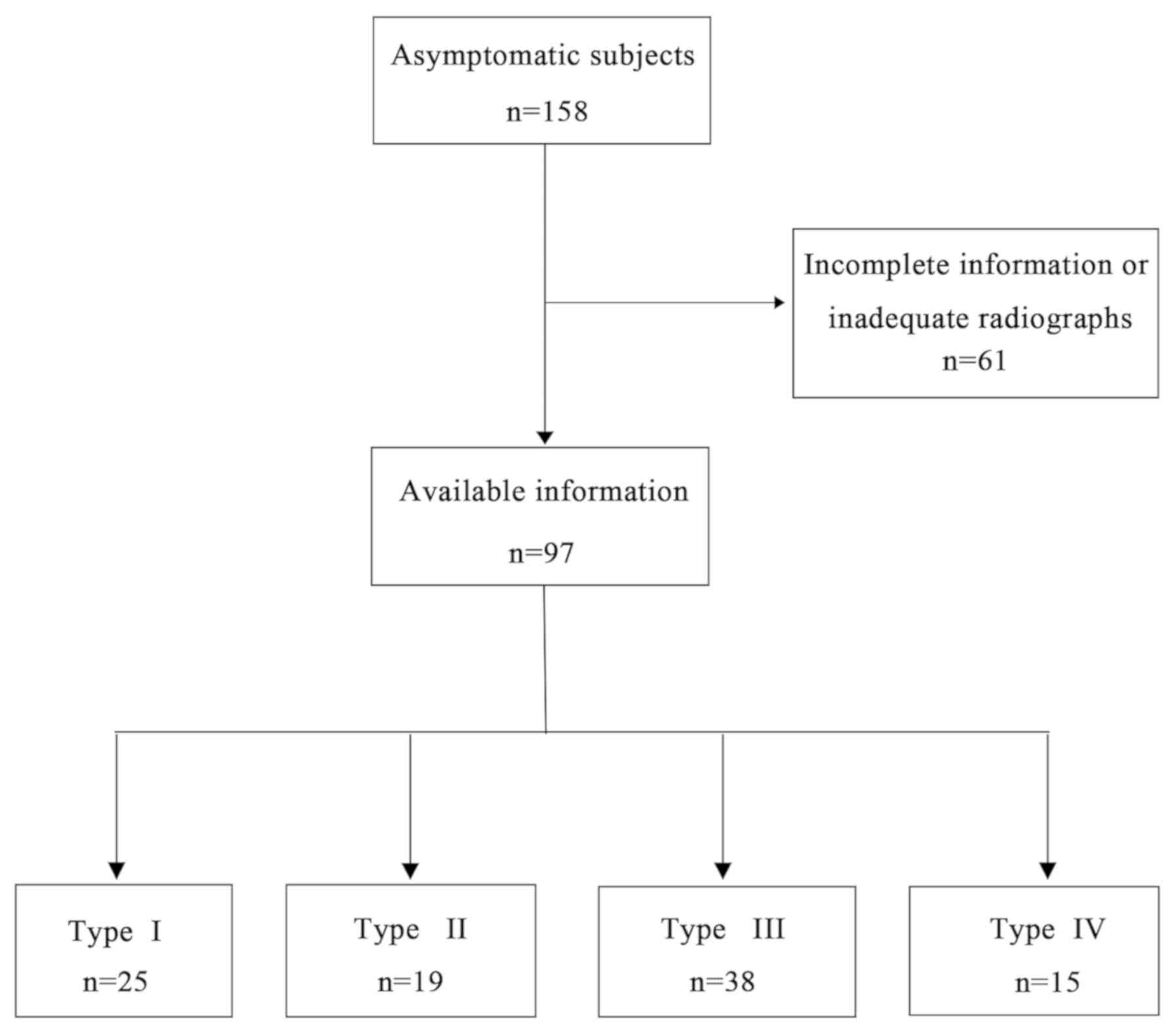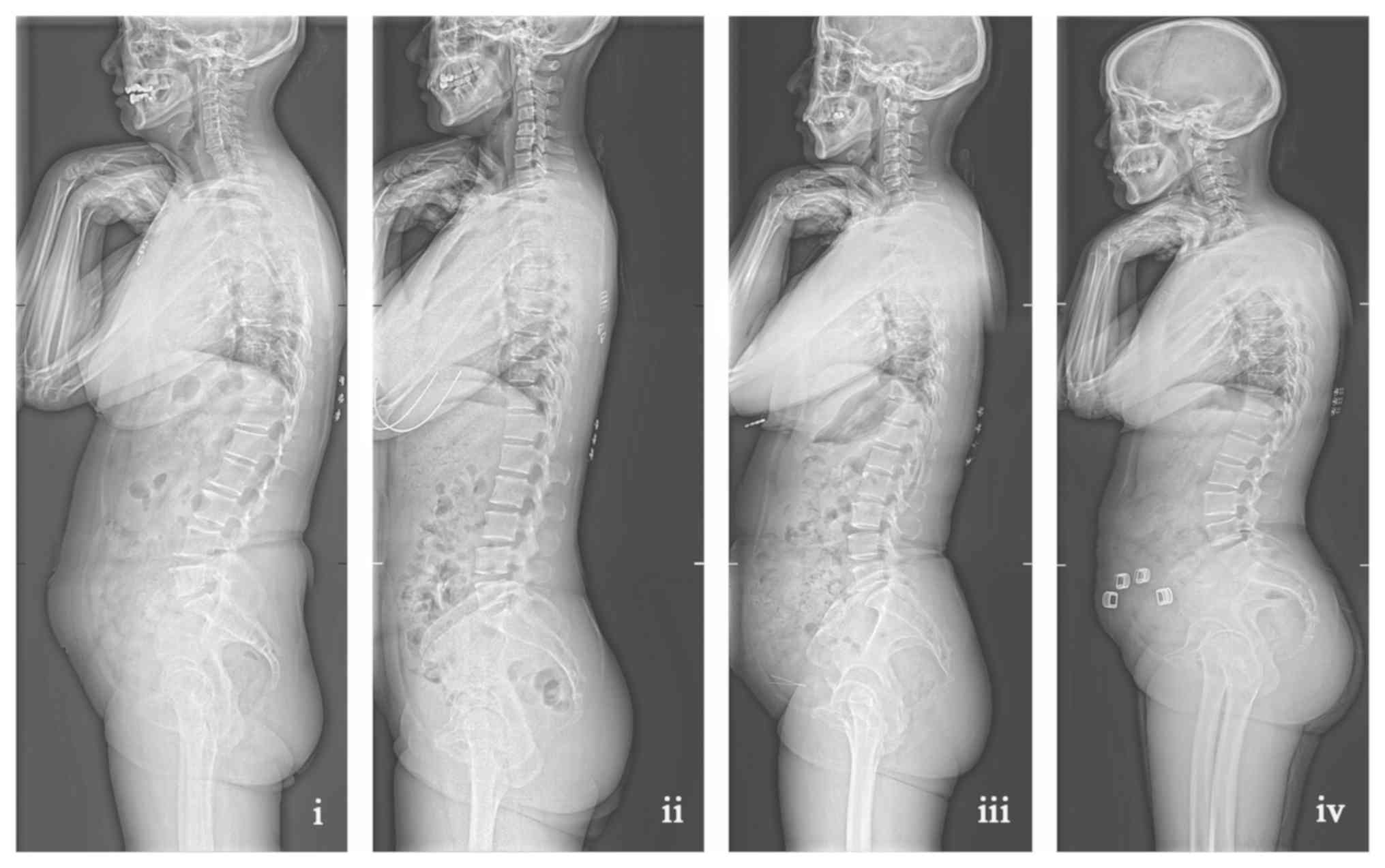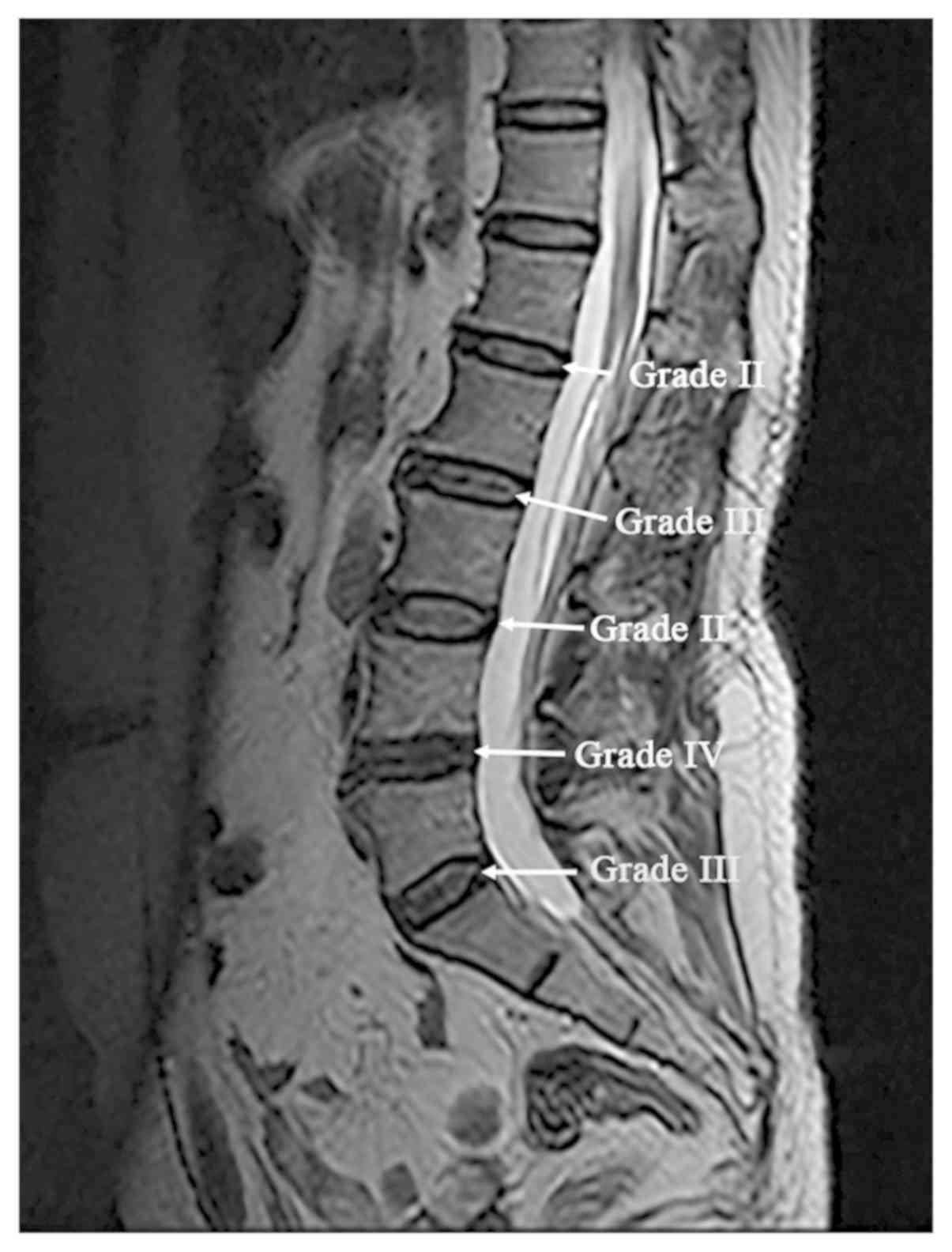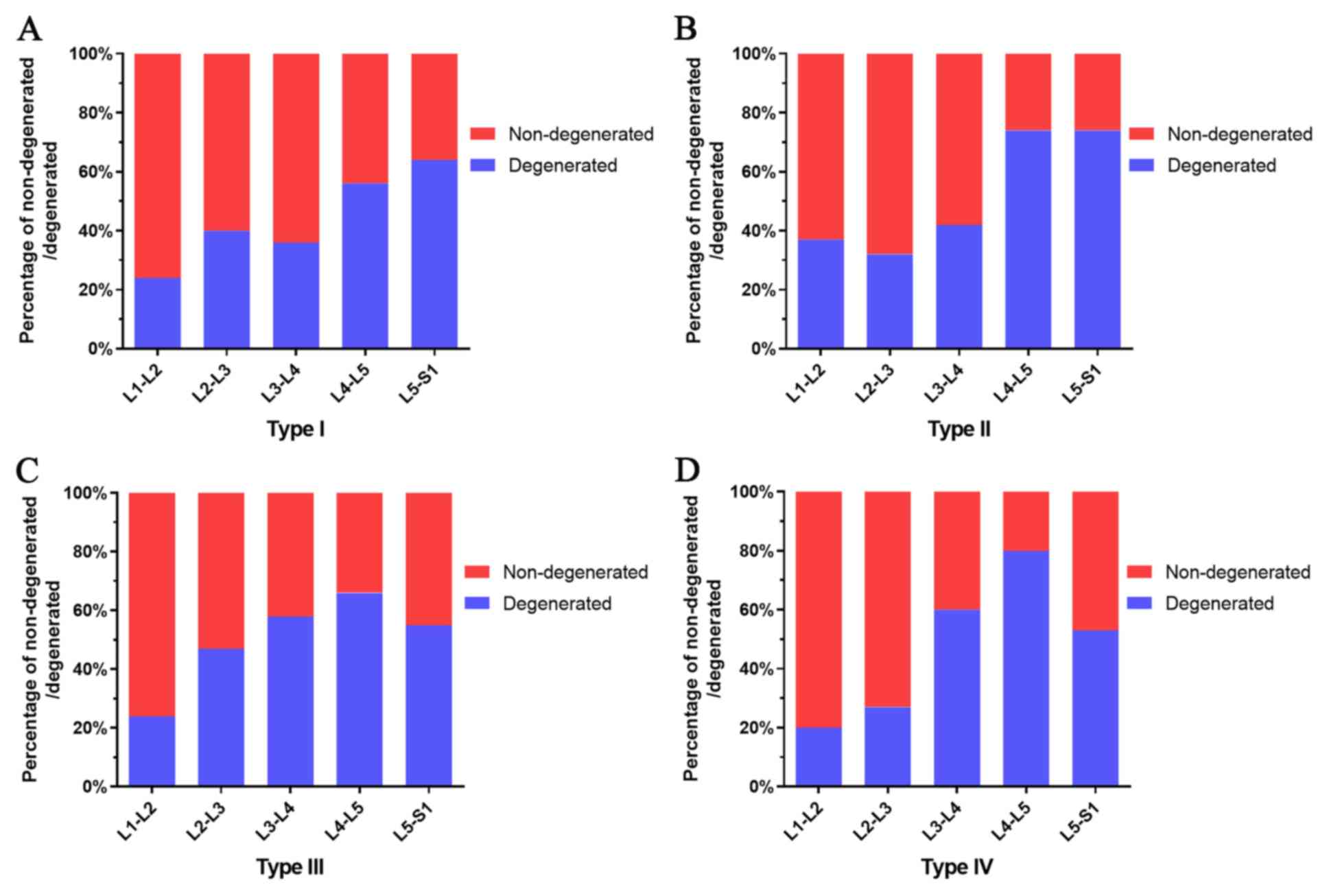|
1
|
Luoma K, Riihimaki H, Luukkonen R,
Raininko R, Viikari-Juntura E and Lamminen A: Low back pain in
relation to lumbar disc degeneration. Spine (Phila Pa 1976).
25:487–492. 2000.PubMed/NCBI View Article : Google Scholar
|
|
2
|
Murray CJ, Vos T, Lozano R, Naghavi M,
Flaxman AD, Michaud C, Ezzati M, Shibuya K, Salomon JA, Abdalla S,
et al: Disability-adjusted life years (DALYs) for 291 diseases and
injuries in 21 regions, 1990-2010: A systematic analysis for the
Global Burden of Disease Study 2010. Lancet. 380:2197–2223.
2012.PubMed/NCBI View Article : Google Scholar
|
|
3
|
Livshits G, Popham M, Malkin I, Sambrook
PN, Macgregor AJ, Spector T and Williams FM: Lumbar disc
degeneration and genetic factors are the main risk factors for low
back pain in women: The UK Twin Spine Study. Ann Rheum Dis.
70:1740–1745. 2011.PubMed/NCBI View Article : Google Scholar
|
|
4
|
Menezes-Reis R, Bonugli GP, Dalto VF, da
Silva Herrero CF, Defino HL and Nogueira-Barbosa MH: Association
between lumbar spine sagittal alignment and L4-L5 Disc degeneration
among asymptomatic young adults. Spine (Phila Pa 1976).
41:E1081–E1087. 2016.PubMed/NCBI View Article : Google Scholar
|
|
5
|
Torrie PA, McKay G, Byrne R, Morris SA and
Harding IJ: The influence of lumbar spinal subtype on lumbar
intervertebral disc degeneration in young and Middle-aged adults.
Spine Deform. 3:172–179. 2015.PubMed/NCBI View Article : Google Scholar
|
|
6
|
Battie MC, Videman T, Gill K, Moneta GB,
Nyman R, Kaprio J and Koskenvuo M: 1991 Volvo Award in clinical
sciences. Smoking and lumbar intervertebral disc degeneration: An
MRI study of identical twins. Spine (Phila Pa 1976). 16:1015–1021.
1991.PubMed/NCBI
|
|
7
|
Hangai M, Kaneoka K, Kuno S, Hinotsu S,
Sakane M, Mamizuka N, Sakai S and Ochiai N: Factors associated with
lumbar intervertebral disc degeneration in the elderly. Spine J.
8:732–740. 2008.PubMed/NCBI View Article : Google Scholar
|
|
8
|
Leino-Arjas P, Kaila-Kangas L, Solovieva
S, Riihimaki H, Kirjonen J and Reunanen A: Serum lipids and low
back pain: An association? A follow-up study of a working
population sample. Spine (Phila Pa 1976). 31:1032–1037.
2006.PubMed/NCBI View Article : Google Scholar
|
|
9
|
Feng Y, Egan B and Wang J: Genetic factors
in intervertebral disc degeneration. Genes Dis. 3:178–185.
2016.PubMed/NCBI View Article : Google Scholar
|
|
10
|
Xia DD, Lin SL, Wang XY, Wang YL, Xu HM,
Zhou F and Tan J: Effects of shear force on intervertebral disc: An
in vivo rabbit study. Eur Spine J. 24:1711–1719. 2015.PubMed/NCBI View Article : Google Scholar
|
|
11
|
Vergroesen PP, Kingma I, Emanuel KS,
Hoogendoorn RJ, Welting TJ, van Royen BJ, van Dieën JH and Smit TH:
Mechanics and biology in intervertebral disc degeneration: A
vicious circle. Osteoarthritis Cartilage. 23:1057–1070.
2015.PubMed/NCBI View Article : Google Scholar
|
|
12
|
Ergun T, Lakadamyali H and Sahin MS: The
relation between sagittal morphology of the lumbosacral spine and
the degree of lumbar intervertebral disc degeneration. Acta Orthop
Traumatol Turc. 44:293–299. 2010.PubMed/NCBI View Article : Google Scholar
|
|
13
|
Roussouly P, Gollogly S, Berthonnaud E and
Dimnet J: Classification of the normal variation in the sagittal
alignment of the human lumbar spine and pelvis in the standing
position. Spine (Phila Pa 1976). 30:346–353. 2005.PubMed/NCBI View Article : Google Scholar
|
|
14
|
Roussouly P and Pinheiro-Franco JL:
Biomechanical analysis of the spino-pelvic organization and
adaptation in pathology. Eur Spine J. 20 (Suppl 5):S609–S618.
2011.PubMed/NCBI View Article : Google Scholar
|
|
15
|
Yan YZ, Shao ZX, Pan XX, Chen SQ, Wu AM,
Tian NF, Wu YS and Wang XY: Acceptable Chin-brow vertical angle for
neutral position radiography: Preliminary analyses based on
parameters of the whole sagittal spine of an asymptomatic chinese
population. World Neurosurg. 120:e488–e496. 2018.PubMed/NCBI View Article : Google Scholar
|
|
16
|
Glassman SD, Berven S, Bridwell K, Horton
W and Dimar JR: Correlation of radiographic parameters and clinical
symptoms in adult scoliosis. Spine (Phila Pa 1976). 30:682–688.
2005.PubMed/NCBI View Article : Google Scholar
|
|
17
|
Aota Y, Saito T, Uesugi M, Ishida K,
Shinoda K and Mizuma K: Does the fists-on-clavicles position
represent a functional standing position? Spine (Phila Pa 1976).
34:808–812. 2009.PubMed/NCBI View Article : Google Scholar
|
|
18
|
Pfirrmann CW, Metzdorf A, Zanetti M,
Hodler J and Boos N: Magnetic resonance classification of lumbar
intervertebral disc degeneration. Spine (Phila Pa 1976).
26:1873–1878. 2001.PubMed/NCBI View Article : Google Scholar
|
|
19
|
Keller TS, Colloca CJ, Harrison DE,
Harrison DD and Janik TJ: Influence of spine morphology on
intervertebral disc loads and stresses in asymptomatic adults:
Implications for the ideal spine. Spine J. 5:297–309.
2005.PubMed/NCBI View Article : Google Scholar
|
|
20
|
Cheung KM, Chan D, Karppinen J, Chen Y,
Jim JJ, Yip SP, Ott J, Wong KK, Sham P, Luk KD, et al: Association
of the Taq I allele in vitamin D receptor with degenerative disc
disease and disc bulge in a Chinese population. Spine (Phila Pa
1976). 31:1143–1148. 2006.PubMed/NCBI View Article : Google Scholar
|
|
21
|
Elfering A, Semmer N, Birkhofer D, Zanetti
M, Hodler J and Boos N: Risk factors for lumbar disc degeneration:
A 5-year prospective MRI study in asymptomatic individuals. Spine
(Phila Pa 1976). 27:125–134. 2002.PubMed/NCBI View Article : Google Scholar
|
|
22
|
Samartzis D, Karppinen J, Mok F, Fong DY,
Luk KD and Cheung KM: A population-based study of juvenile disc
degeneration and its association with overweight and obesity, low
back pain, and diminished functional status. J Bone Joint Surg Am.
93:662–670. 2011.PubMed/NCBI View Article : Google Scholar
|
|
23
|
Yang X, Kong Q, Song Y, Liu L, Zeng J and
Xing R: The characteristics of spinopelvic sagittal alignment in
patients with lumbar disc degenerative diseases. Eur Spine J.
23:569–575. 2014.PubMed/NCBI View Article : Google Scholar
|
|
24
|
Battie MC and Videman T: Lumbar disc
degeneration: Epidemiology and genetics. J Bone Joint Surg Am. 88
(Suppl 2):S3–S9. 2006.PubMed/NCBI View Article : Google Scholar
|
|
25
|
Chan D, Song Y, Sham P and Cheung KM:
Genetics of disc degeneration. Eur Spine J. 15 (Suppl 3):S317–S325.
2006.PubMed/NCBI View Article : Google Scholar
|
|
26
|
Cheung KM: The relationship between disc
degeneration, low back pain, and human pain genetics. Spine J.
10:958–960. 2010.PubMed/NCBI View Article : Google Scholar
|
|
27
|
Kalichman L and Hunter DJ: The genetics of
intervertebral disc degeneration. Associated genes. Joint Bone
Spine. 75:388–396. 2008.PubMed/NCBI View Article : Google Scholar
|
|
28
|
Williams FM, Popham M, Sambrook PN, Jones
AF, Spector TD and MacGregor AJ: Progression of lumbar disc
degeneration over a decade: A heritability study. Ann Rheum Dis.
70:1203–1207. 2011.PubMed/NCBI View Article : Google Scholar
|
|
29
|
Munir S, Rade M, Maatta JH, Freidin MB and
Williams FMK: Intervertebral disc biology: Genetic basis of disc
degeneration. Curr Mol Biol Rep. 4:143–150. 2018.PubMed/NCBI View Article : Google Scholar
|


















